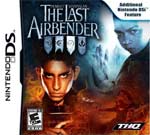Bending the Elements
The Last Airbender may prove to be the death knell of M. Night Shyamalan’s directing career, but surprisingly, it inspired a decent DS title. The game isn’t a masterpiece by any means, and it can be completed in five hours or so, but developer Halfbrick put together a solid experience.

This game is aimed directly at fans of the Avatar: The Last Airbender anime series, so story plays a large role. It picks up where the movie left off. You control two different characters at various points in the game. One is Prince Zuko, who can throw fireballs and otherwise manipulate flame, and who has an alter ego, the stealthy Blue Spirit. Zuko’s goal is to capture the Avatar, a powerful “Airbender” who can fire gusts of air and learns how to “bend” (that is, manipulate) water partway through the game. The other character is Aang, the Avatar. His goal is to avoid being captured and protect his community from an attack by Zuko’s people, the Fire Nation.
There’s even some character development here, as Prince Zuko has misgivings about his mission and Aang struggles to grow into his role as the Avatar. It’s not exactly Shakespeare, but the plot adds to Airbender lore, and it moves forward in short, well-done cutscenes that don’t interfere with the flow of the gameplay.
Speaking of gameplay, it borrows heavily from the DS’s Zelda titles, but the emphasis on projectiles, as opposed to swords and shields, helps distinguish it. Also, there are some light RPG elements; you can improve your characters’ powers by collecting currency and spending it in the pause menu. We found the ability to instantly kill enemies you’ve knocked down to be especially helpful.

The Last Airbender gets off to a slow start (there are too many hand-holding training missions, especially for experienced gamers), but an hour or so in, everything falls into place. The developers struck a great balance between fighting off rank-and-file enemies, taking on bosses, and solving puzzles. There isn’t much variety in the basic enemies (they’re mostly just guards who attack with swords or projectiles), but it’s fun to hack, slash, and burn your way through them between sets of puzzles. The puzzles themselves involve a variety of tasks including pushing blocks around and manipulating fire, air, and water to open the way forward. The boss fights also offer a lot of variety, with each foe being defeated in a different way. This is a kids’ game, so don’t expect a lot of challenge, but a couple of the puzzles are tough, and until you figure out the trick (spoiler alert: use a special move to knock them off guard before attacking them), the enemies with shields can be a pain.
The controls work well, and they’re simple enough that kids should have no problem; the entire game is played with the stylus and the L button (R for lefties, of course). The stylus enables you to move and attack enemies, while the L button puts you into your “Bend Stance,” in which you can perform your character’s special moves. It’s completely intuitive and rarely gave us any problems.

The Last Airbender excels on a visual level as well. The game is linear, but it takes you through a variety of settings, including a ship and a town where you do your training, in a sizable 3-D world. The cutscenes look great and capture the series’ anime feel. We encountered only one hiccup: about halfway through the game, we managed to get our character stuck and had to restart the console. Thanks to the frequent checkpoints, the glitch didn’t cost us more than a minute or two.

The sound is a serious problem, however. The music seems to be going for a Zelda meets anime feel, but it’s far too hyper and gets annoying long before you’ve finished the game. The cymbals in some of the songs are especially irritating coming through the DS’s tinny-sounding speakers. The sound effects, meanwhile, are not noticeably good or bad.
The other significant problem is the game’s short length. If you’re diligent about collecting currency, you’ll have unlocked all of the special powers by the time the credits roll, so there’s not much of a reason to go back through searching for secrets. Thirty dollars for a fun five-hour experience that ties into a beloved cartoon series (and a terrible movie) isn’t a ripoff, but it’s not really a deal either. All but the most diehard fans should probably wait for this one to come down in price.
In addition, The Last Airbender won’t do much for gamers who aren’t already fans of the series. There’s not much challenge, and there’s nothing groundbreaking about the gameplay. It pales in comparison with its obvious inspiration, The Legend of Zelda: Phantom Hourglass. (Then again, what game doesn’t?) We doubt most non-fans will even give this title a second glance, but those who do should be wary.
For the countless children who love the series (and made their parents take them to that awful film), the game is a great way to continue the experience. The puzzles, combat, and boss fights will keep these fans occupied for a few hours, and the cutscenes tell a story they’ll want to experience. That’s a lot more than you can say for most movie games.
RATING OUT OF 5 RATING DESCRIPTION 4.3 Graphics
This title has well-done cutscenes and in-game environments. 5.0 Control
They’re more or less stolen from Phantom Hourglass, so they’re perfect. 1.4 Music / Sound FX / Voice Acting
Annoying music and generic sound effects make up the game’s audio. 3.5
Play Value
It’s only a few hours long, but it’s fun while it lasts.
3.8 Overall Rating – Good
Not an average. See Rating legend above for a final score breakdown.
Game Features:
